How To Hit Slow Pitching, Improve Batting Timing Rhythm Mechanism, & STOP Swinging Early For Beginner Baseball And Softball | Drills & Tips For Better Hitting
Discover how to hit slow pitching, improve batting timing and rhythm mechanism, and STOP swinging early. For beginner baseball and softball players. Learn simple drills and tips for better more on-time hitting…
Brandon Moss Swing Analysis REVEALS Slow Pitcher Timing Secret
This Brandon Moss analysis comes from a conversation I had with Coach Justin Karr and his 12-U Bakersfield Sliders Black team. Thanks Coach Karr, I hope this helps your troops!
I want to compare what Brandon Moss does differently hitting a slower pitcher, like knuckle-baller R.A. Dickey of the Toronto Blue Jays, to a hard throwing “King” Felix Hernandez of the Seattle Mariners. We’re going to:
- Make the complicated, uncomplicated,
- Learn how-to adjust to slower pitching according to Brandon Moss, and
- Discuss what a hitter can do to adjust timing.
Make the Complicated, Uncomplicated
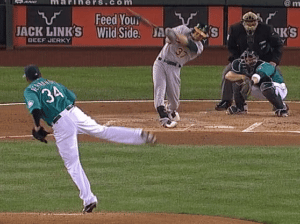
Brandon Moss photo courtesy: MLB.com
First of all, executing flawless hitting mechanics mean nothing if timing is off. I love how Dr. Kelly Starrett describes learning complicated movements (or strategies) in his book Becoming A Supple Leopard: The Ultimate Guide to Resolving Pain, Preventing Injury, and Optimizing Athletic Performance:
“When it comes to learning complicated movements efficiently, the key is to make them uncomplicated. We do this by breaking them down into precise, manageable steps. Then we emphatically encourage like-your-life-depends-on-it focus in performing each step. This is the path to a tight learning curve. It’s the foundation required for optimal performance.”
We focus on one aspect at a time. In respect to the calibration of timing, we have to forget swing mechanics and focus solely on adjusting the timing. Making in-game adjustments, timing is THE most important priority. We teach three possible swing adjustments with our seven hitting strategies. We refer to these as the three dimensional hitting adjustments:
- Timing – is hitter out front or behind?
- Vertical (Launch Angle) – did hitter hit popup or ground-ball (or line drive?), and
- Horizontal (Barrel Path) – did hitter get jammed or hit ball off the end?
Which one of these after an in-game swing, if tweaked, fixes the other two?
SCIENCE-BASED TRAINING:
Improve your hitting strategy dramatically by applying human movement principles.
Learn not only how and what to train but also the science behind the methods.
How-To Adjust to Slower Pitching According to Brandon Moss
In the video, I compare and analyze two 2013 home-run swings by the Oakland A’s first baseman Brandon Moss:
- 77 mph knuckle-ball from R.A. Dickey Moss (left-handed) hit over the center field fence (418 feet*), and
- 93 mph fastball from “King” Felix Hernandez Moss hit over the right-center field fence (387 feet*)
(*You can find out more home-run stats at BaseballSavant)
CLICK HERE to revisit a video blog article I did, featuring Josh Hamilton and Mike Trout, where I went over:
- When does a swing start?
- Leg kick or slide step? and
- How to practice timing?
For an average velocity pitcher, each hitter MUST figure out at what point in the pitcher’s delivery that they start their swing. Then experiment starting the swing at a later point with a slower pitcher. This will be slightly different for every hitter as the Josh Hamilton article shows.
The main point is, the hitter has to make a a conscience effort to change their timing. They can’t just use the same timing for every pitcher. Hitting is a game of inches…being one inch ahead or behind can mean barreling the ball or not.
What’s the best way to practice this? The 2-plate drill shared in this article, and home run derby?? Using the 2-plate drill and throwing seated from 25-30 feet away (under or over hand front toss). The thrower will be literally lobbing the ball to the hitter as they take two swings and switching plates. Six swings per round. The slower the throw, the better. In our system, this is hitting strategy number 4.
Also, if the whole team’s offensive numbers are suffering against a slower pitcher, then the adjustment DOES NOT necessarily have to be a mechanical one.
One more interesting point…notice how far Brandon Moss cranked the Dickey knuckle-ball? 418 feet!! “King” Felix? 387 feet…a pitcher’s velocity doesn’t dramatically contribute to batted ball distance. It’s bat speed that does. According to a forum at eFastball.com, for every 1 mph of added pitching velocity, 1 foot of batted ball distance is the outcome. BUT for every 1 mph of increased bat speed, 4 feet of batted ball distance is the result!! Don’t let low velocity pitchers slow your bat speed down hitters!
- Fix Late Swings Fast: 2025 Pitch Recognition & See-Decide-Swing Training for Youth Baseball Power Hitters - October 6, 2025
- Safe Youth Weighted Bat Training: Proven Overload/Underload Drills to Increase Exit Velocity in Games Starting Tonight - September 29, 2025
- AI Coaching Course 2025: Youth Baseball & Softball Practice Plan + Off-Season & In-Season Workout Builder Fast - September 23, 2025

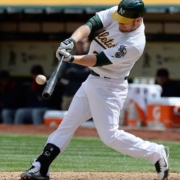

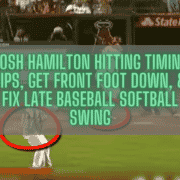




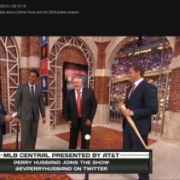
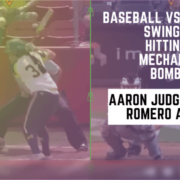



Hi Joey have enjoyed and benefitted from /your insight and knowledge, have been following you for number of years along with Chas. I am looking for specific hand inside drills, I want to be careful to not go to short to long through would barrel tight to shoulder barrel towards pitcher be appropriate off of tee or swing away? Thank you for your consideration
Jim, I’m glad you’re getting a lot out of the videos. I’m not quite understanding your question…I try and stay away from “hands inside” cues. It gets hitters to think about moving their hands versus getting their torso/spine to move their hands. If I’m understanding you correctly, try getting the hitter to imagine a steel rod going through the knob/hands into the back shoulder. This is how the hitter should initiate their turn. OR you can try getting them to use the knob to trace the plane of the pitch. Both these cues are good whole body ones.
thanks that makes sense, I have a hitter that tends to get around the ball rather than staying inside. i think in part he his barring front arm he is getting good bottom half rotaion and generates good power.
Also making sure your hitter has a slight down shoulder angle and is showing his numbers at the Fight Position (landing) may help too.
My sons travel team crosses paths against the Bakersfield Sliders Black team frequently, and the way every batter in the lineup has a distinct ‘pro-style’ swing, moving with the pitcher instead of after delivery is unmistakable. Now the question is how do we get our boys all doing it?
Jim, good question. Like what the coaches and I did with the B-Sliders, we broke things down and introduced new movements over time. It depends on what your team needs work on…power, maintaining barrel on the plane of the pitch longer, FoMo, Vision, Tracking & Timing, etc. This will give a good idea of where to strike first.
Joey,
Not sure whether it’s a good idea for hitters to change delivery timing. It can obviously work with a 16 mile an hour difference between pitches. But most fastballs regardless pitchers are within 3 to 5 miles an hour range. And many pitchers fastball have a range of 3 to 5 miles an hour. You also run into the problem of accurately judging pitch speed – something my 6th grader struggled with when he tried to change pitch delivery timing based on the estimated speed of the pitcher. It also got tricky because some tournaments were 50/70 and others 54/80.
Young hitters might be better off developing a general pitch delivery timing for most pitchers with a gap to gap mentality. If they are slightly early, the pull the pitch. If there are slightly late, the pitch is hit the opposite way. That’s the benefit if getting the barrel in the hitting zone for as long as possible.
Now if the hitter is late, the hitter must advance his delivery timing. I just think it’s easier starting delivery timing earlier than later. And if you slow down your timing on a slow pitcher, aren’t you making a slow pitcher a fast pitcher.
The two plate drill really helps with timing. But I think it helps more with reaction timing as opposed to delivery timing, if you can get my point.
Mark,
The purpose of this post was to show the difference in swing start between a faster versus slower pitcher. There MUST be a re-calibration in timing in such case. There are macro (pitcher to pitcher) AND micro changes (within the At-Bat). This post touches on the macro…the 2-plate drill is great for training this. You mentioned a lot of the micro timing changes…building “fail-safes” into the swing are crucial because a hitter cannot control pitch type, speed, and location. Sorry for the post confusion.